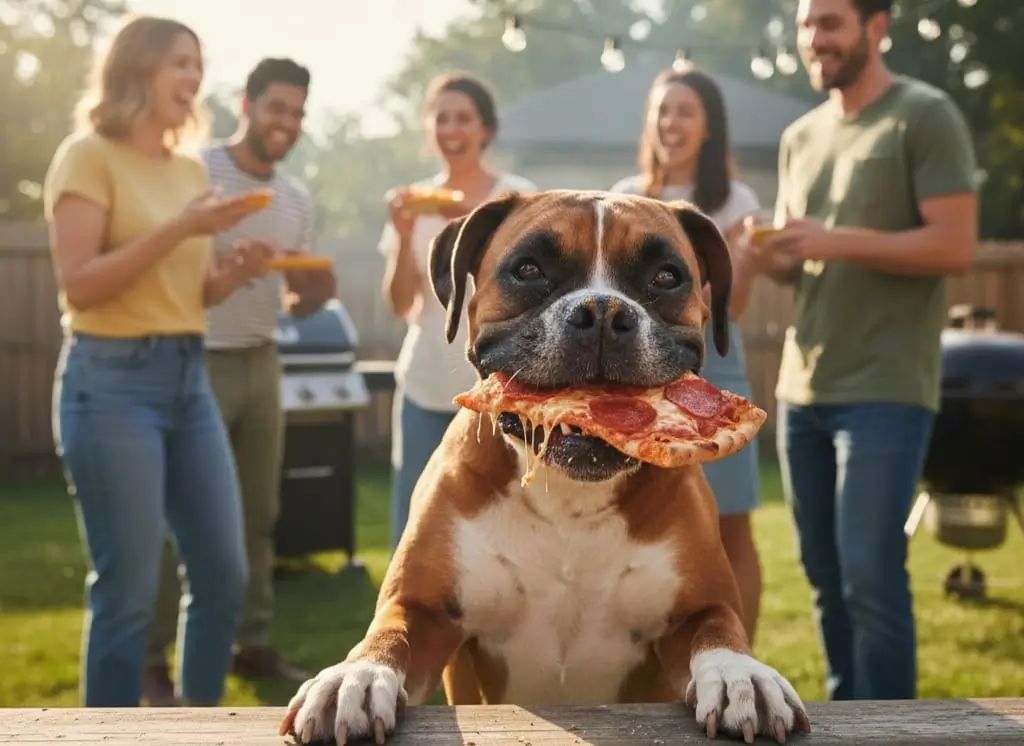No, pizza is not safe for dogs as a regular treat. A small lick may not harm a healthy adult dog, but common pizza ingredients like onions, garlic, high-fat meats, raw dough, and excessive salt can cause serious issues—from stomach upset to pancreatitis or onion/garlic toxicity. If your dog ate pizza, monitor for symptoms and call your vet if needed.
Why Can’t Dogs Eat Pizza Safely?

Pizza is a risky treat for dogs due to several harmful ingredients packed into one dish:
- Onions & Garlic (including powder): Part of the Allium family, these can damage red blood cells, leading to hemolytic anemia. Even small amounts in pizza sauce or seasonings are dangerous.
- High-Fat, Salty Meats (pepperoni, sausage, bacon): These increase the risk of vomiting, diarrhea, and pancreatitis—a painful inflammation of the pancreas that affects 1 in 5 dogs fed high-fat diets (source: Veterinary studies).
- Cheese & Dairy: Many dogs are lactose intolerant. Cheese is high in fat and salt, potentially causing digestive upset or worse in sensitive dogs.
- Raw/Yeasted Pizza Dough: Expands in the stomach and ferments into alcohol, risking bloat, alcohol toxicosis, or stomach damage—a veterinary emergency.
- Excess Salt & Spices (oregano, chili flakes): Can cause gastrointestinal upset, and some spices are toxic in large amounts.
These factors make pizza a poor choice for dogs, even as an occasional treat. For safer options, check out our guide to dog-safe treats.
Are Pizza Ingredients Toxic to Dogs?
Here’s a breakdown of common pizza ingredients and their risks:
- Tomato Sauce: Plain, ripe tomatoes are safe in tiny amounts, but pizza sauce often contains garlic, onions, salt, or sugar—making it risky.
- Cheese: Low-fat, low-lactose cheese (e.g., mozzarella) may be okay in small amounts for some dogs, but avoid it if your dog is lactose intolerant.
- Dough: Raw dough is dangerous due to yeast fermentation; cooked crust is high in carbs, adding empty calories and potentially causing diarrhea.
- Processed Meats: Pepperoni, sausage, and bacon are fatty, salty, and often seasoned with garlic/onion powder, raising pancreatitis risk.
Can Dogs Eat Pizza Toppings?

Most pizza toppings are unsafe for dogs due to high fat, salt, or toxic ingredients. Here’s a detailed look at common toppings:
Unsafe Toppings to Avoid
- Pepperoni, Sausage, Bacon, Ham, Salami: These processed meats are high in fat and salt, often seasoned with garlic or onion powder, increasing the risk of pancreatitis and toxicity.
- Onions, Garlic, Chives, Scallions: All forms (raw, cooked, powdered) are toxic, as they can cause red blood cell damage (hemolytic anemia).
- Olives with Pits: Pits pose a choking hazard, and olives are high in salt, which can lead to digestive upset.
- Unripe (Green) Tomatoes: Contain solanine, a toxin harmful to dogs in large amounts.
- Excessive Pineapple: While small amounts are okay, too much pineapple can cause digestive issues due to high sugar content.
Safe Toppings (in Moderation)
- Plain Cooked Chicken or Turkey: Must be skinless, unseasoned, and given in tiny amounts to avoid excess calories.
- Plain Mushrooms (Store-Bought): Small amounts of cooked, unseasoned mushrooms (like button or cremini) are safe, but avoid wild mushrooms, which can be toxic.
- Bell Peppers: Small pieces of plain, unseasoned bell peppers (red or green) are safe as an occasional treat. Avoid spicy varieties like jalapeños.
- Pineapple: Tiny amounts of plain, fresh pineapple can be a sweet treat, but keep portions small to avoid sugar overload.
Key Takeaway: Most pizza toppings are too salty, fatty, or seasoned to be safe. If you must share, stick to tiny amounts of plain, unseasoned options, but always consult your vet for your dog’s specific needs.
Can Dogs Eat Pizza Crust?
A small piece of plain, fully baked crust is unlikely to cause severe harm in healthy adult dogs, but it’s not healthy. Crust is high in calories, salt, and fat (if butter/oil is used), potentially triggering diarrhea or vomiting, especially in small breeds or sensitive dogs. Raw dough is a medical emergency due to expansion and fermentation. If your dog ate raw dough, contact your vet immediately.
Can Dogs Eat Pizza Rolls or Frozen Pizza Snacks?
Pizza rolls and frozen pizza snacks are worse than regular pizza. They’re packed with concentrated salt, fat, processed meats, and often garlic/onion powder. These increase the risk of pancreatitis and toxicity. If your dog eats pizza rolls, monitor for vomiting, diarrhea, or lethargy, and consult a vet if symptoms appear.
My Dog Ate Pizza—What Should I Do?
- Stay Calm: A single bite may only cause mild stomach upset in most dogs.
- Assess the Situation: Note the amount and ingredients (e.g., plain crust vs. onion-heavy slice). Toxic ingredients like garlic, onions, or xylitol (in dips) are high risk.
- Monitor Symptoms: Watch for vomiting, diarrhea, abdominal pain, lethargy, pale gums, rapid heartbeat, or difficulty breathing within 6–48 hours.
- Contact a Vet: Call your veterinarian or a poison control line if toxic ingredients were consumed or if your dog ate a large amount.
- Act Fast for Raw Dough: Raw dough ingestion requires immediate veterinary care due to expansion and alcohol production.
Dog-Safe Alternatives to Pizza
Instead of sharing pizza, try these vet-approved options:
- Plain Cooked Lean Meats: Chicken or turkey (no bones, skin, or seasoning).
- Vegetables: Carrots, green beans, or plain cooked sweet potato/pumpkin (not pie filling).
- Fruits: Small apple slices (no seeds) or plain blueberries in moderation.
- Commercial Dog Treats: Choose treats formulated for canine digestion, like these vet-recommended options.
Dog-Friendly “Pizza” Recipe
Want to treat your pup to a pizza-inspired snack? Try this vet-approved, dog-safe “pizza” recipe:
Ingredients (for a small dog):
- Crust: ½ cup whole-grain oat flour + ¼ cup water (or use a pre-baked dog biscuit).
- Sauce: 2 tbsp plain canned pumpkin (no additives).
- Toppings: 1 tbsp shredded, unseasoned cooked chicken + 1 tsp low-fat mozzarella (optional, skip for lactose-intolerant dogs).
Instructions:
- Mix oat flour and water to form a dough. Roll out and bake at 350°F for 10–12 minutes until firm.
- Spread a thin layer of pumpkin as “sauce.”
- Sprinkle chicken and a pinch of cheese (if using).
- Cut into bite-sized pieces and let cool before serving.
Serving Size: 1–2 small pieces for a 20-lb dog; adjust based on weight. Consult your vet for calorie needs.
Pizza-Themed Fun for Dogs
Keep the pizza vibe without the risks:
- Dog-Safe Treats: Try pizza-shaped commercial treats (check our top picks).
- Pizza Toys: Engage your dog with pizza-themed toys, like these durable options.
- DIY Content: Create a pup-pizza tutorial video for your blog or social media to boost engagement.
Conclusion
Pizza is a human favorite but a risky choice for dogs due to toxic ingredients (onions, garlic), high fat/salt content, and dangerous raw dough. If your dog sneaks a bite, monitor for symptoms like vomiting or lethargy, and call your vet if toxic toppings were involved. Instead, try dog-safe alternatives or our vet-approved “pizza” recipe.
FAQ
Q: Can dogs eat cheese pizza safely?
A: Small amounts of plain cheese pizza might not be toxic, but cheese is high in fat and salt, risking diarrhea or pancreatitis. Avoid making it a habit.
Q: Is marinara sauce safe for dogs?
A: Plain tomatoes are okay in tiny amounts, but marinara often contains garlic, onions, and salt—making it unsafe.
Q: My dog ate raw pizza dough—what now?
A: Raw dough is a medical emergency due to expansion and fermentation. Contact your vet immediately.
Q: How quickly does onion/garlic poisoning show up in dogs?
A: Symptoms (weakness, pale gums, rapid heartbeat) may appear within hours to days. Call your vet or ASPCA Poison Control if ingestion is suspected.
Q: Are vegan pizzas safer for dogs?
A: Not necessarily—vegan pizzas often contain garlic, onions, or high salt/oil. Always check ingredients.
Q: Can puppies eat pizza?
A: No, puppies are more sensitive to toxic ingredients and high-fat foods. Stick to puppy-safe treats.

